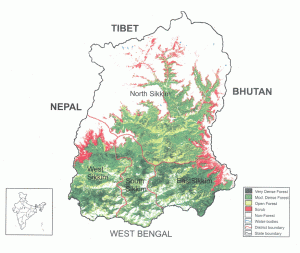Sikkim : Schemes and Projects
Various schemes have been implemented in the State for the growth and development. In order to provide inclusive growth and provide equal benefits and opportunities to all the people, schemes have been launched.
Various schemes are as
Chief Ministers Start Up Scheme
In order to develop entrepreneurship to young minds , this scheme has been launched. In this scheme, 25% subsidy will be provided with an investment of up to Rs. 20 lakhs. This Scheme is being launched with the objective to boost entrepreneurship and encourage start-up ventures by providing them with financial support. Initially a sum of Rs. 10 crores is being earmarked during this fiscal.
Health
Proud Mother Scheme
A new scheme has been launched with initial allocation of Rs. 5 crores, known as “Proud Mother Scheme” which provides a cash incentive of Rs. 7000 at the time of birth of the first child and another Rs. 10,000 at the time of birth of the second child.
Chief Minister’s Annual and Total Health Checkup (CATCH)
It is first of its kind public Health care initiative in the country .The programme’s first phase covering more than 95% of total population has been completed.
In this health profile of all the citizens have to be made. It provides comprehensive health care with focus on health promotions and preventions of by annual and periodical head to toe health check up free of cost. for all the citizens of Sikkim.
Mukhya Mantri Jeevan Raksha Khosh
It was started in the state during 2014-15, by the state government under which financial assistance of US$ 0.03 million would be provided to the patients. The patients under the BPL category would be granted a financial assistance of US$ 0.05 million.
Rural Development
Mukhyamantri Nagar Awas Yojana
The state government has launched Mukhyamantri Nagar Awas Yojana. Under this scheme, the Sikkim government will construct 250 residential housing units. The decision was taken by the Sikkim Housing & Development Board.
A list of the beneficiaries of Mukhyamantri Nagar Awas Yojana will be prepared by the state government. Besides this, the state government has also approved housing scheme of flats in east Sikkim. Although this scheme will be joint ventured under the state government and the private agencies but houses will be provided to the poor people of the state.
Green Mission
Sikkim Organic Mission
State has voluntarily adopted Organic mission and act as a role model for the whole world.
The process for bringing total cultivable land of 58,168 hectare under Organic Mission has been started in 2010. Agencies accredited by Agriculture and Processed Food Products Export Development Authority are certifying the organic process in
Organic products like fruits and vegetables not only provide additional value to the farmers but also provides multiple benefits. It also supplements the ecotourism of the Sikkim .
Sikkim Green Mission
State Green Mission has completed 12 years in June 2017. Its main aim is to boos t green measures in the state. The mission envisages in avenue plantation and beautification of all vacant and waste lands It protects roads from sides and also in maintaining aesthetic beauty for the travelers.
10 minutes to Earth Mission
Six lakh saplings of trees and flowering plants are planted every year within 10 minutes just before monsoon since 2009. This will help in sequestering carbon dioxide from the atmosphere.
The forest department provides free saplings to other departments and other organizations. It is also being done in Urban areas, as in these areas ornamental flowers and shrubs have been planted.
Universal Financial Inclusion
The Chief Minister’s Rural Universal Financial Inclusion Programme was launched during the Independence Day Celebration on 15th Aug, 2010. The programme aims to provide universal access to formal banking services to rural Sikkim, provide easy access to formal financial services, ensure inclusive and equitable growth, empower rural women and to accelerate economic development in rural areas in general.
It will also provide insurance services related to house and personal accident to the beneficiary families. Under this programme, about 70,000 rural families in the State will be benefited by opening a savings bank account in the name of the mother of the nuclear family. They will be able to operate this account through a composite biometric smart bank card. The facility for savings and withdrawals from these bank accounts will be provided in the Gram Panchayat Unit itself by opening 163 Points of Service (PoS) facilities to be operated by Banking Business Correspondents as per the Reserve Bank of India guidelines.
Self Sufficiency Mission
Government has made significant strides in transforming it as a producer State particularly in regard to enhancement of produce from the agriculture and allied sectors. State is working hard to ensure that all kinds of demands created in the State are met within the State. And state wants to see the people of Sikkim themselves fulfill local demands by becoming producers of goods and services. State has been successful in achieving 100% chicken meat and eggs self sufficiency within the State. Government is striving towards creating vital infrastructure for training, value addition and marketing in this sector to enable people to become producers.
Social Security Mission
Under the mission, the State government has initiated various schemes for different age groups. Various shelter homes for welfare of distressed women have been established. Besides, the State government has introduced welfare schemes for Scheduled Castes, Scheduled Tribes, Most Backward Classes and Other Backward Classes. The schemes are in the form of scholarships, inputs to farmers belonging to marginalized section of society, Scheduled Caste sub-plan and Tribal sub-plan and establishments of a development corporation for the various communities.
Government has worked relentlessly to guarantee full socio-cultural and economic security to all section of the people on a larger canvass of human centric development. Special dispensation in various forms and formats is bring provided to the needy and deserving sections of citizens belonging to various social groups, differently abled persons, old aged and vulnerable groups.
Skill Development Mission
The Skill Development Initiative was launched in 2003 and apart from the Directorate of Capacity Building, the State Institute of Capacity Building at Karfectar with state of the art facilities for residential training have been established. Under the Chief Minister’s Self-Employment Scheme 5,780 youths have been covered for self-vocational ventures encompassing various agro-based activities and IT and Tourism related vocations.. Many boys and girls primarily from rural areas are undergoing different kinds of vocational up gradation trainings in such Institutes across the State.
Chief Minister’s Self Reliant Mission
Objective : Main objective is to empower youth to realise their full potential and understand their roles and responsibilities in making full contribution to the development. This mission plays the significant role in creating employment opportunity thereby making financial independent by setting micr0 small and medium enterprise in the state.
Various sectors include
Industrial-Manufacturing, Processing & preservation of food items.
Animals Husbandry-Dairy, piggery, Poultry , bee keeping.
Tourism-Rural tourism, eco tourism, gust house, home stays, cyber cafes, restaurant/fast food ,travel agencies, adventure tourism(pare gliding , rafting, trekking).
Handicrafts-indigenous handicraft like carpet & ravi weaving ,woodcraft, traditional painting ,tailoring ,jewellery, black smithy.
Agriculture, Floriculture & horticulture-organic seed production ,ginger, cardamom, orange & apple plantation. ,vermin compost, bio-fertilizer production, orchid production, seasonal flower production etc.
IT Sector-computer hardware, software programming, web designing. Creative Sector-Fashion design, interior design draftsmanship.
Sikkim Tourism Policy 2015
To create a plan for the development of human resources in the tourism sector. Providing a quality experience to tourists by enhancing the infrastructure and transport facilities in the state.
To promote tourism in the state of Sikkim by creating a marketing cell within the Tourism Department.
To establish Sikkim as an ultimate and unique ecotourism destination, offering memorable and high quality learning experiences to visitors to contribute to poverty alleviation and promote nature conservation.
To promote ecotourism in a sustainable manner based on the Global Sustainable Tourism Criteria.
IT Policy of Sikkim
To provide better governance and generate employment.
To improve productivity in government departments through computerization.
To promote the Northeast as an attractive investment destination through several concessions and incentives.

